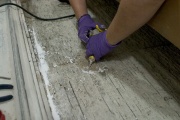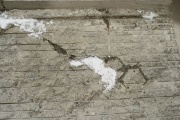Difference between revisions of "Paraloid B-72"
| Line 4: | Line 4: | ||
[Rohm & Haas] A registered trademark for a clear, colorless, thermoplastic acrylic resin. Paraloid B-72 (formerly called Acryloid B-72 in the United States) is composed of an ethyl methacrylate (70%) and methyl acrylate (30%) copolymer. It was a shown to be a very stable resin for use in conservation (Feller 1972). Initially, Paraloid B-72 was supplied as white irregular lumps with a slight acrylic acid smell and a composition of ethyl methacrylate (68%) and methyl acrylate (28%); by 1976 the product changed to the odorless, transparent globules (de Witte et al 1978). Commercially, Paraloid B-72 is used as a general purpose coating. It produces a stable, wear resistant, nonyellowing finish. It is compatible with vinyl, cellulosic, and silicone resins. In conservation, Paraloid B-72 has been used as a coating, consolidant, and adhesive. Paraloid B-72 is supplied as solid pellets or as a 50% solids solution in toluene (Paraloid B-72 50%). | [Rohm & Haas] A registered trademark for a clear, colorless, thermoplastic acrylic resin. Paraloid B-72 (formerly called Acryloid B-72 in the United States) is composed of an ethyl methacrylate (70%) and methyl acrylate (30%) copolymer. It was a shown to be a very stable resin for use in conservation (Feller 1972). Initially, Paraloid B-72 was supplied as white irregular lumps with a slight acrylic acid smell and a composition of ethyl methacrylate (68%) and methyl acrylate (28%); by 1976 the product changed to the odorless, transparent globules (de Witte et al 1978). Commercially, Paraloid B-72 is used as a general purpose coating. It produces a stable, wear resistant, nonyellowing finish. It is compatible with vinyl, cellulosic, and silicone resins. In conservation, Paraloid B-72 has been used as a coating, consolidant, and adhesive. Paraloid B-72 is supplied as solid pellets or as a 50% solids solution in toluene (Paraloid B-72 50%). | ||
| − | [[File:DT 9-29-2004 08-B72 and microballoon fills.jpg|thumb|Paraloid B-72 and | + | [[File:DT 9-29-2004 08-B72 and microballoon fills.jpg|thumb|Paraloid B-72 and microballoon fills]] |
| − | |||
== Synonyms and Related Terms == | == Synonyms and Related Terms == | ||
| Line 13: | Line 12: | ||
[[[SliderGallery rightalign|Paraloid B-72 FTIR.PNG~FTIR]]] | [[[SliderGallery rightalign|Paraloid B-72 FTIR.PNG~FTIR]]] | ||
| − | == | + | == Applications == |
| + | |||
| + | == Risks == | ||
| − | + | Talas: [http://talasonline.com/photos/msds/b72.pdf MSDS] | |
| − | + | == Physical and Chemical Properties == | |
| − | Slightly soluble in isopropanol. | + | *Soluble in toluene, xylene, acetone, carbon tetrachloride, MEK. |
| − | + | *Paraloid B-72 made after 1976 is soluble in ethanol. | |
| − | Insoluble in aliphatic hydrocarbons, water, oils, grease. | + | *Slightly soluble in isopropanol. |
| + | *Insoluble in aliphatic hydrocarbons, water, oils, grease. | ||
{| class="wikitable" | {| class="wikitable" | ||
| Line 31: | Line 33: | ||
| 1.479-1.489 | | 1.479-1.489 | ||
|} | |} | ||
| − | |||
| − | |||
| − | |||
| − | |||
== Additional Information == | == Additional Information == | ||
Revision as of 13:26, 19 May 2020
Description
[Rohm & Haas] A registered trademark for a clear, colorless, thermoplastic acrylic resin. Paraloid B-72 (formerly called Acryloid B-72 in the United States) is composed of an ethyl methacrylate (70%) and methyl acrylate (30%) copolymer. It was a shown to be a very stable resin for use in conservation (Feller 1972). Initially, Paraloid B-72 was supplied as white irregular lumps with a slight acrylic acid smell and a composition of ethyl methacrylate (68%) and methyl acrylate (28%); by 1976 the product changed to the odorless, transparent globules (de Witte et al 1978). Commercially, Paraloid B-72 is used as a general purpose coating. It produces a stable, wear resistant, nonyellowing finish. It is compatible with vinyl, cellulosic, and silicone resins. In conservation, Paraloid B-72 has been used as a coating, consolidant, and adhesive. Paraloid B-72 is supplied as solid pellets or as a 50% solids solution in toluene (Paraloid B-72 50%).
Synonyms and Related Terms
Acryloid B-72; Paraloid B72; Paraloid B-72; Acryloid B-72 (sp); Acryloid B72 (sp); Paraloid B72 (Port.)
Applications
Risks
Talas: MSDS
Physical and Chemical Properties
- Soluble in toluene, xylene, acetone, carbon tetrachloride, MEK.
- Paraloid B-72 made after 1976 is soluble in ethanol.
- Slightly soluble in isopropanol.
- Insoluble in aliphatic hydrocarbons, water, oils, grease.
| Molecular Weight | Tg = 40 C |
|---|---|
| Refractive Index | 1.479-1.489 |
Additional Information
Jerry Podany, Kathleen M. Garland, William R. Freeman, Joe Rogers, "Paraloid B-72 as a Structural Adhesive and as a Barrier Within Structural Adnesive Bonds: Evaluations of Strength and Reversibility" JAIC 40(1), 2001 (link).
J. Down, M.MacDonald, J.Te'treault, S.Williams, "Adhesive Testing at the Canadian Conservation Institute-An Evaluation of Selected Poly(Vinyl acetate) and Acrylic Adhesives", Studies in Conservation 41:19-44, 1996.
E. de Witte, M.Goessens-Landrie, E.J.Goethals, T.Simonds, "The Structure of 'Old' and 'New' Paraloid B72", ICOM preprints 78/16/3/1-9, Zagreb, 1978.
R.L.Feller, N.Stolow, E.H.Jones, On Picture Varnishes and their Solvents, the press of Case Western Reserve University, Cleveland, 1972.
Links to Oddy Test results posted on AIC Wiki Materials Database Pages for individual materials below
Paraloid B72 tested in 2013
Authority (List of sources checked for information on this material)
- Ralph Mayer, A Dictionary of Art Terms and Techniques, Harper and Row Publishers, New York, 1969 (also 1945 printing)
- Paintings Specialty Group, Painting Conservation Catalog, Wendy Samet (ed.), AIC, Washington, DC, 1998
- Book and Paper Group, Paper Conservation Catalog, AIC, 1984, 1989
- Marie Svoboda, Conservation Survey Index, unpublished, 1997
- Conservation Support Systems, Catalog, 1997
- Product Information Comment: Rohm and Haas acryloid acrylic resins sheet.1986
- External source or communication Comment: CoOL DistList 2/10/2002
- Website address 1 Comment: www.rohmhaas.com


